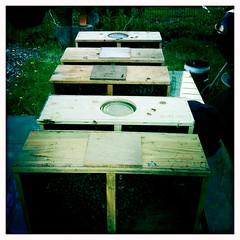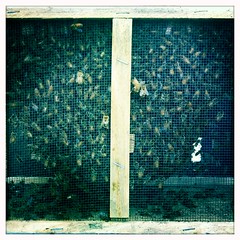
So after a few harrowing weeks of worried waiting, we got our packages! Well, technically they're from a different company than the ones we originally ordered, but they're here!
So what are packages anyway? In a nutshell, they're bees in bulk--which is undeniably weird. They are also the most basic of the three main ways you can get started as a beekeeper.
If you don't have hives to make splits from (or you don't want to reduce your current hives' population to make those splits), you have three options. You can get a fully functioning hive, which includes 2 hive bodies, 20 frames, brood, honey, pollen, several thousand bees and their queen ($$$); OR you can get a nucleus, which includes 5 frames of brood, honey and pollen, 10,000 bees and their queen ($$); OR you can get a package which is 3 pounds of bees in a box and a queen in a cage ($) (check out a video of the queen marking process here).
I say a queen instead of their queen because in packages they don't know each other yet. And this is actually the riskiest part of the whole 'bees by the pound' process: the workers aren't guaranteed to want or like the queen you give them. A queen a big commitment for them; they need time to figure her out. In fact, if the bees don't like the queen (unfortunately, last year lent us some experience with this), or if something catastrophic or annoying happens to the hive during this introductory phase, they'll blame it on the queen, kill her and try to raise a new one (we'll go into that process later). This doesn't necessarily spell doom for your hive, but it will set them back a few weeks.
Beekeepers have a neat way of enabling a gradual introduction of the queen with the hope that the workers will grow to trust her. When you get a package of bees, the queen is actually in a little cage with a few "attendants." A thick chunk of soft candy plugs the exit, which the attendants eat and then feed the queen. When you put your bees into their new
 |
| shaking the package into the hive |
We were fortunate on Sunday to have BEAUTIFUL weather, hot even. Despite the light wind, everything worked out really really well with the package install (below is a video of Grant installing one of them) and by the end of the day we saw bees hauling pollen back to their new homes!
We keep telling ourselves these bees are not really ours. They are not domesticated, they don't need us, and frankly, they'd probably rather do without our intermittent poking and prodding. But we can't help feeling like their guardians now; that this process is one of adoption. "You're in a good place, ladies," we told them. "there's a variety of great food to eat, no major pesticides, no bears. We'll do our best to keep off the mites & pests and you'll be just fine."


No comments:
Post a Comment